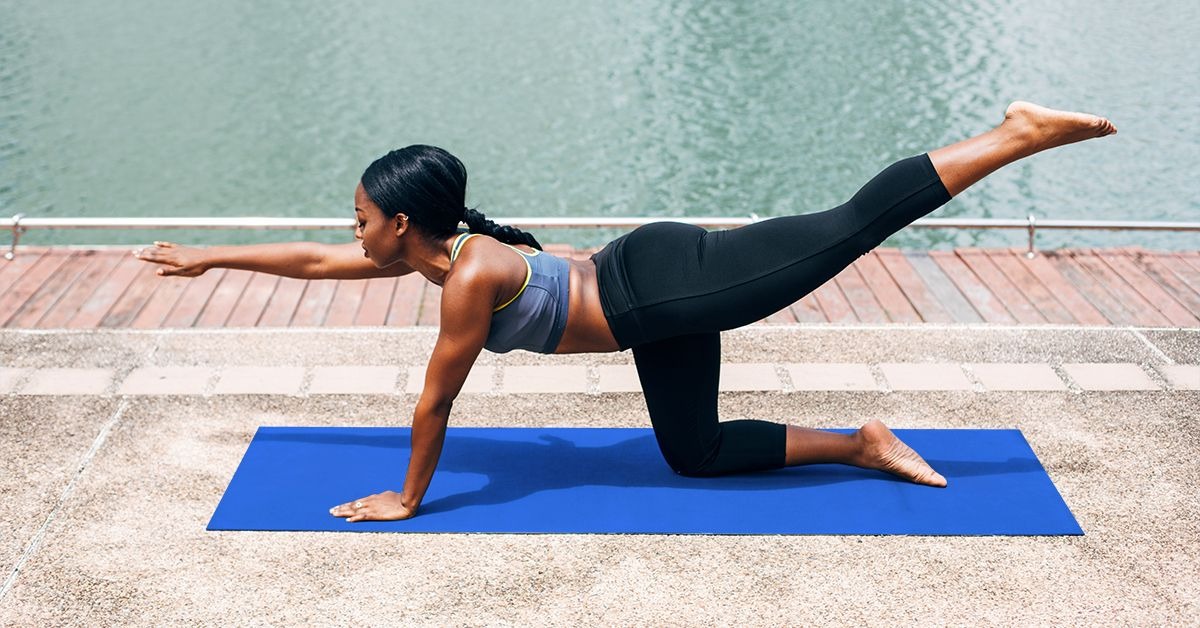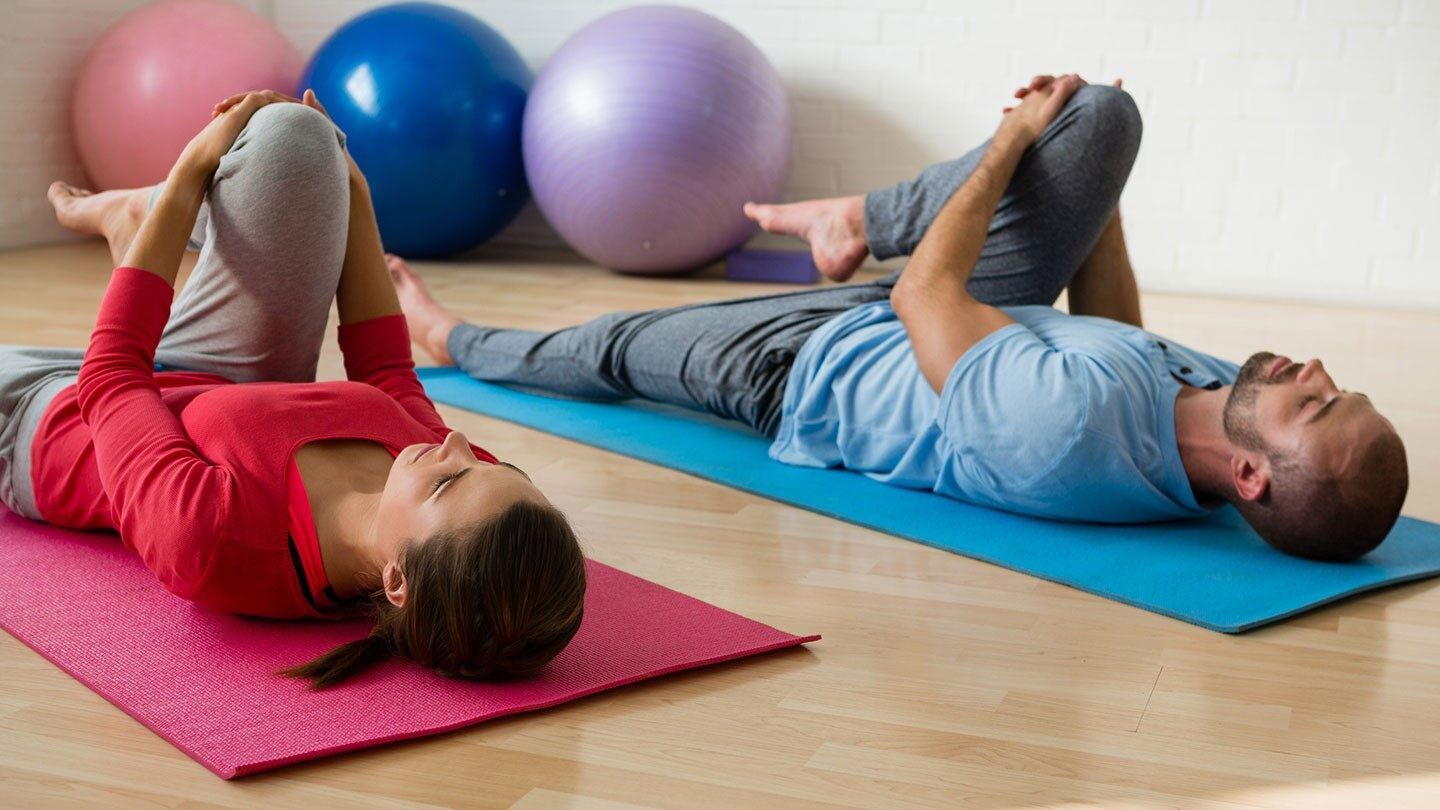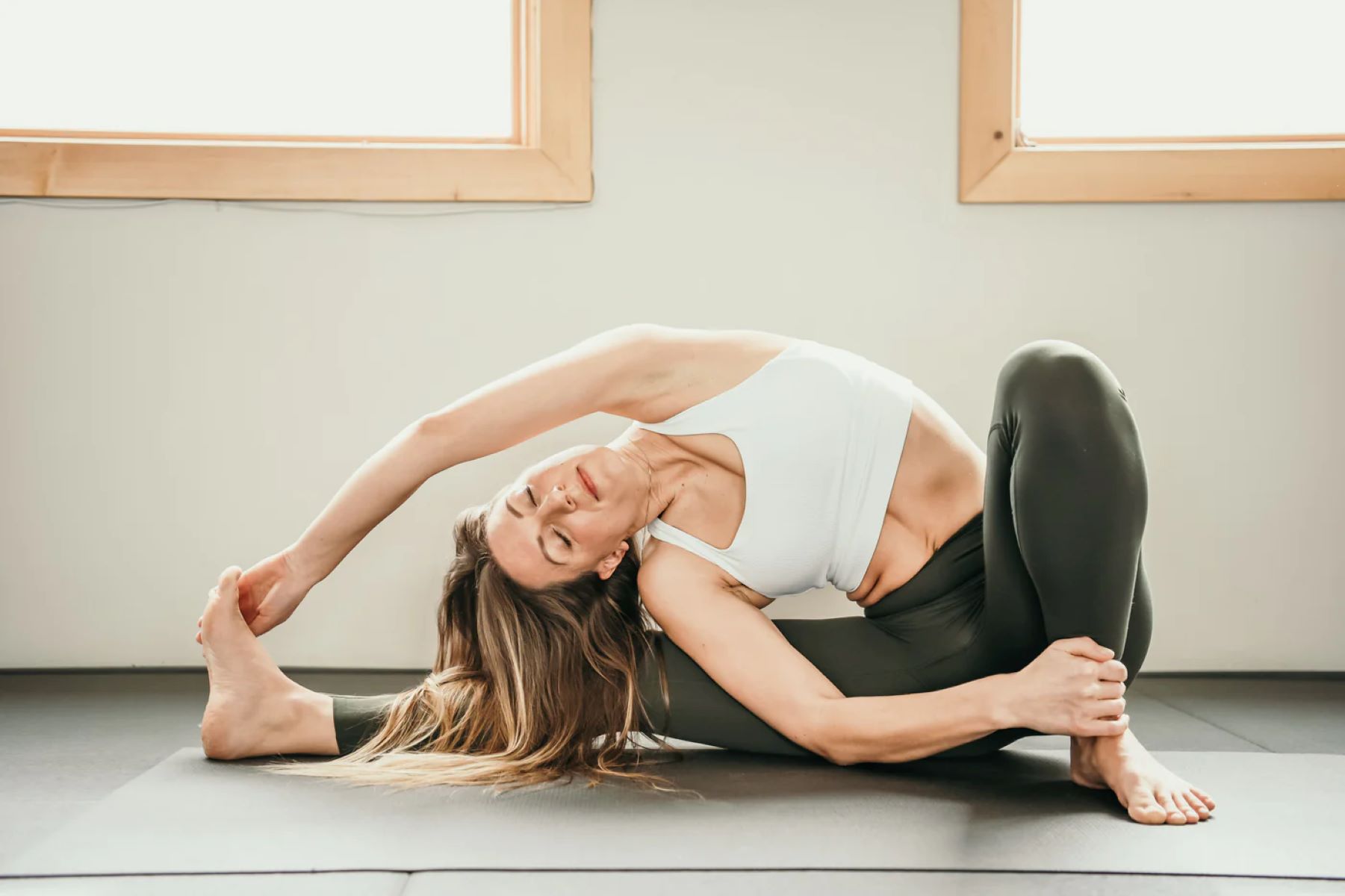

Featured
What Type Of Exercise Is Yoga
Published: October 3, 2023
Discover the featured exercise that combines strength, flexibility, and mindfulness - Yoga. Explore different types of yoga and find the perfect practice for you.
Introduction
Yoga has become increasingly popular in recent years, with millions of people around the world embracing this ancient practice. Originating in ancient India, yoga is more than just a physical exercise; it is a holistic approach that encompasses the body, mind, and spirit. Through a combination of physical postures, breathing techniques, meditation, and mindfulness, yoga offers a wide range of benefits for individuals of all ages and fitness levels.
Yoga is not only a form of exercise but also a philosophy and a way of life. It goes beyond simply working out the body to encompass a deeper understanding of oneself and the world around us. The word “yoga” itself means union, signifying the harmonization of body and mind. By practicing yoga, individuals can find balance, improve flexibility, reduce stress, and cultivate a sense of inner peace.
Yoga is a versatile practice that offers something for everyone. Whether you are looking to increase strength and flexibility, manage stress, find mental clarity, or simply improve overall well-being, there is a style of yoga that can meet your needs.
In this article, we will explore the various types of yoga, the physical and mental benefits it offers, as well as some helpful tips for beginners and advanced practitioners. Whether you are new to yoga or have been practicing for years, this article will provide valuable insights and guidance to help you optimize your yoga journey.
Benefits of Yoga
Yoga offers a multitude of benefits for both the body and the mind. From improving flexibility and strength to reducing stress and promoting relaxation, the advantages of practicing yoga are extensive. Let’s take a closer look at some of the key benefits:
- Physical Benefits: Regular practice of yoga can significantly enhance flexibility, as it stretches and strengthens muscles, tendons, and ligaments. It also improves posture, balance, and coordination, leading to a better overall physical alignment. Additionally, yoga can increase strength, boost metabolism, and promote weight loss.
- Mental and Emotional Benefits: Yoga is renowned for its ability to reduce stress and promote relaxation. Through deep breathing and meditation techniques, it helps calm the mind, relieve anxiety, and improve sleep quality. Yoga also enhances mental clarity, focus, and concentration, allowing for a greater sense of well-being and inner peace.
- Stress Reduction: One of the most significant benefits of yoga is its capacity to reduce stress. By practicing yoga, individuals can activate the body’s relaxation response, which helps counteract the effects of chronic stress. This can lead to lower blood pressure, decreased heart rate, and an overall sense of calmness and tranquility.
- Improved Flexibility: Yoga postures, also known as asanas, involve stretching and lengthening the muscles, leading to improved flexibility and range of motion. Increased flexibility can enhance athletic performance, prevent injuries, and ease everyday movements and tasks.
- Enhanced Strength and Stability: Many yoga poses require strength and stability to maintain proper alignment. As you progress in your practice, you will notice increased muscle tone and strength, particularly in the core, arms, and legs. This added strength can improve overall physical fitness and prevent muscle imbalances.
These are just a few examples of the many benefits that yoga can provide. Whether you are seeking physical fitness, mental clarity, stress relief, or a combination of these, incorporating yoga into your routine can have a profound positive impact on your overall well-being.
Different Types of Yoga
Yoga encompasses a wide range of styles, each with its own unique focus and approach. While all types of yoga share the common goal of uniting the body and mind, they differ in terms of intensity, pace, and specific techniques. Here are some of the most popular types of yoga:
- Hatha Yoga: Hatha yoga is a gentle and slow-paced style that is perfect for beginners. It focuses on basic postures (asanas) and breathing techniques (pranayama). Hatha yoga is a great starting point for building strength, flexibility, and balance.
- Vinyasa Yoga: Vinyasa yoga, also known as flow yoga, is a more dynamic and energetic style that involves linking breath with movement. Vinyasa classes often include a sequence of flowing postures, giving you a cardiovascular workout while improving strength and flexibility.
- Ashtanga Yoga: Ashtanga yoga is a physically demanding and structured style that follows a specific sequence of poses. It involves synchronized breathing and continuous movement to generate inner heat and purify the body. Ashtanga yoga is ideal for those seeking a challenging and disciplined practice.
- Bikram Yoga: Bikram yoga, also known as hot yoga, is practiced in a heated room with a temperature of approximately 105°F (40.6°C). Classes consist of a fixed sequence of 26 postures and two breathing exercises, promoting detoxification and deep stretching.
- Iyengar Yoga: Iyengar yoga focuses on alignment and precise movements. Props such as blocks, straps, and blankets are often used to assist in achieving proper alignment. Iyengar yoga is beneficial for those recovering from injuries or seeking a more therapeutic practice.
- Kundalini Yoga: Kundalini yoga combines physical postures, breathing techniques, chanting, and meditation to awaken the dormant spiritual energy located at the base of the spine. This dynamic and transformative practice aims to release energy blockages, expand consciousness, and promote spiritual growth.
These are just a few examples of the many types of yoga available. Exploring different styles can help you find the one that resonates with your goals, preferences, and ability level. Remember, there is no “right” or “wrong” type of yoga – what matters is finding a practice that makes you feel good and supports your well-being.
Physical Benefits of Yoga
Yoga offers a multitude of physical benefits that can positively impact your overall health and well-being. Regular practice of yoga can enhance strength, flexibility, balance, and posture, while also promoting better breathing and circulation. Here are some of the key physical benefits of yoga:
- Increased Flexibility: Yoga poses, or asanas, involve stretching and lengthening the muscles, tendons, and ligaments. Over time, this improves flexibility and range of motion, making everyday movements easier and reducing the risk of injury.
- Improved Strength: Yoga engages various muscle groups, helping to strengthen and tone the body. Poses that require holding yourself up, such as plank or warrior poses, build core, arm, and leg strength. Regular practice can lead to increased muscle definition and improved overall physical fitness.
- Better Balance and Coordination: Many yoga poses require balance and stability. By practicing balancing poses, such as tree pose or eagle pose, you can improve your proprioception (awareness of your body in space) and enhance balance and coordination.
- Corrected Posture: Yoga helps align and strengthen the spine, leading to improved posture. Asanas that focus on opening the chest and lengthening the spine, like mountain pose or cobra pose, can counteract the negative effects of slouching and sitting for long periods.
- Enhanced Breathing: The breathing techniques, or pranayama, practiced in yoga help increase lung capacity, improve diaphragmatic breathing, and promote oxygenation of the body. This can lead to better respiratory health and increased energy levels.
- Improved Circulation: Yoga poses that involve twisting and inverting the body, such as seated twists or shoulder stands, can enhance blood flow, lymphatic drainage, and overall circulation. This can contribute to healthier organs, improved detoxification, and a stronger immune system.
By engaging in regular yoga practice, you can experience these physical benefits and improve your overall physical well-being. Remember, the key to reaping these benefits is consistent and mindful practice. Listen to your body, be patient with yourself, and enjoy the journey of exploring what your body is capable of.
Mental and Emotional Benefits of Yoga
Yoga not only benefits the body but also provides numerous mental and emotional advantages. The mindfulness, breathwork, and meditation involved in a yoga practice can promote relaxation, reduce stress, and enhance overall emotional well-being. Here are some of the key mental and emotional benefits of yoga:
- Stress Reduction: Yoga is renowned for its ability to reduce stress levels. By focusing on the present moment and connecting with your breath, yoga helps activate the body’s relaxation response. This can lead to a decrease in cortisol levels, blood pressure, and heart rate, resulting in a calmer state of mind.
- Improved Mental Clarity: The practice of yoga encourages mental clarity and focus. Through mindful movement and conscious breathing, yoga helps quiet the mind and improve cognitive function. This can result in enhanced concentration, memory, and overall mental performance.
- Emotional Stability: Regular yoga practice can enhance emotional stability and resilience. The combination of movement, breathwork, and meditation supports the regulation of emotions, allowing you to respond to challenging situations with a greater sense of calmness and equanimity.
- Increased Self-Awareness: Yoga promotes self-awareness by encouraging you to connect with your body, thoughts, and emotions. By cultivating present moment awareness, you can gain insight into your patterns of thinking and behaving. This self-awareness can lead to personal growth, improved decision-making, and a deeper understanding of yourself.
- Enhanced Mind-Body Connection: Yoga helps foster a stronger connection between the body and mind. Through the integration of physical postures, breath control, and meditation, you can develop a deeper sense of embodiment. This can lead to a greater appreciation for your body, increased self-acceptance, and improved overall well-being.
- Promotes Relaxation and Better Sleep: The relaxation techniques practiced in yoga, such as savasana (corpse pose), induce a state of deep relaxation and promote better sleep. By incorporating yoga into your routine, you can experience more restful nights and wake up feeling refreshed and rejuvenated.
By incorporating yoga into your lifestyle, you can experience these mental and emotional benefits. It is important to approach your yoga practice with an open mind, allowing yourself to fully immerse in the present moment and embrace the transformative power of the practice.
Yoga for Beginners
If you’re new to yoga, starting a yoga practice can seem intimidating or overwhelming. However, with the right approach and mindset, yoga can be accessible and enjoyable for beginners. Here are some helpful tips to get started with yoga:
- Find a Beginner-Friendly Yoga Class: Look for beginner-friendly yoga classes or studios that offer introductory courses. These classes often focus on foundational poses and provide more guidance for beginners.
- Start with Basic Poses: Begin with simple poses that help you build strength, flexibility, and body awareness. Some common beginner poses include Mountain Pose, Downward Facing Dog, and Warrior II. Focus on proper alignment and listen to your body’s limitations.
- Set Realistic Expectations: Yoga is a journey, and progress takes time. Be patient with yourself and avoid comparing your practice to others. Embrace the process and enjoy the experience of discovering and exploring your body’s capabilities.
- Listen to Your Body: Pay attention to how your body feels during practice. If a pose feels uncomfortable or painful, modify it or skip it altogether. Always honor your body’s boundaries and avoid pushing yourself too far to avoid injuries.
- Breathe Mindfully: Conscious breathing is a crucial part of yoga. Focus on deep, steady breaths throughout your practice, allowing the breath to guide your movements. This helps calm the mind, increase body awareness, and cultivate mindfulness.
- Practice Regularly: Consistency is key in yoga. Aim for regular practice, even if it’s just a few minutes each day. This allows your body to gradually adapt and improve over time. Remember that every practice is an opportunity for growth, no matter how short or simple.
- Seek Guidance and Support: Consider working with a qualified yoga instructor who can offer personalized guidance and adjustments. They can help you with proper alignment, modifications, and provide answers to any questions or concerns you may have.
Remember, yoga is a personal practice, and it’s important to listen to your body and honor your individual needs. Don’t be afraid to modify poses or take breaks during your practice. The most important thing is to approach yoga with an open mind, a sense of curiosity, and a willingness to learn and grow.
Yoga for Advanced Practitioners
For those who have been practicing yoga for a while and have developed a solid foundation, advancing your yoga practice can bring new challenges and opportunities for growth. Here are some tips to take your yoga practice to the next level:
- Explore Advanced Poses: As an advanced practitioner, you may want to explore more challenging poses that require greater strength, flexibility, and balance. Poses like headstands, arm balances, and deep backbends can be incorporated into your practice to deepen your physical and mental capabilities.
- Deepen Your Mind-Body Connection: As you progress in your practice, focus on deepening your mind-body connection. Cultivate a sense of mindfulness and presence during your practice, allowing for a more profound experience and understanding of the interconnectedness of your body and mind.
- Refine Alignment and Technique: Advanced practitioners often benefit from refining their alignment and technique in postures. Work with a experienced yoga teacher or attend workshops that focus on specific aspects of your practice, such as inversions, hip openers, or backbends. This can help you enhance your practice and prevent injuries.
- Challenge Yourself Mentally: While physical practice is essential, advanced yoga also involves challenging yourself mentally. Experiment with longer holds, explore new variations, and test your mental focus and endurance. Pushing past boundaries and overcoming mental obstacles can lead to profound personal growth.
- Explore Different Yoga Styles: Advanced practitioners can benefit from exploring different yoga styles, such as Yin yoga, Kundalini yoga, or Jivamukti yoga. Trying new styles can deepen your understanding of yoga philosophy, expand your skill set, and offer new perspectives on your practice.
- Cultivate a Self-Practice: Establishing a regular self-practice can be transformative for advanced practitioners. Set aside time each day to explore poses, sequences, and meditation techniques that resonate with you. This self-guided practice allows you to tune in to your specific needs and goals.
- Share Your Knowledge: Consider sharing your knowledge and experience by becoming a yoga teacher or guiding others in their yoga journey. Teaching can deepen your own understanding of yoga, provide a sense of fulfillment, and allow you to contribute to the yoga community.
Remember to approach your advanced practice with humility, patience, and self-compassion. Listen to your body and honor its limitations, as pushing too hard can lead to injury. Advanced yoga is a continuous journey of growth and exploration, and the most important aspect is maintaining a sense of curiosity, openness, and gratitude for the practice.
Precautions and Considerations
While yoga is generally safe for most individuals, it is important to practice with caution and consider certain factors to ensure a safe and enjoyable experience. Here are some precautions and considerations to keep in mind:
- Physical Limitations: If you have any pre-existing medical conditions or physical limitations, consult with your healthcare provider before starting a yoga practice. Certain poses may need to be modified or avoided to accommodate your individual needs.
- Warm-Up Properly: Before diving into more challenging poses, it is important to warm up your body properly. Performing gentle stretches and joint movements at the beginning of your practice helps prepare your muscles and prevents injuries.
- Listen to Your Body: Always listen to your body and respect its limits. Avoid pushing yourself into poses that feel painful or uncomfortable. Progress at your own pace and honor your body’s signals of pain or discomfort.
- Avoid Comparisons: Yoga is a personal practice, and everyone’s journey is unique. Avoid comparing yourself to others in the class or on social media. Focus on your own progress and celebrate the achievements, no matter how small they may seem.
- Stay Hydrated: Drink plenty of water before, during, and after your yoga practice to stay hydrated. Sweating during a vigorous practice can lead to dehydration, so it is important to replenish your fluids regularly.
- Use Props when Needed: Props such as blocks, straps, and bolsters can be helpful in maintaining proper alignment and providing support. Utilize props to modify poses and make them more accessible for your body.
- Inform Your Instructor: If you are attending a class, inform your instructor about any injuries, limitations, or concerns you may have. They can provide modifications and offer guidance to ensure a safe practice.
- Avoid Overexertion: It can be tempting to push yourself to the limits, especially when you see others performing advanced poses. However, overexertion can lead to strain or injury. Practice patience and allow your body to gradually progress.
By taking these precautions and considerations into account, you can create a safe and supportive environment for your yoga practice. Remember that yoga is a lifelong journey, and it is important to approach it with mindfulness, self-care, and a deep respect for your body’s capabilities and boundaries.
Conclusion
Yoga is much more than just a physical exercise; it is a transformative practice that offers numerous benefits for the body, mind, and spirit. Whether you are a beginner or an advanced practitioner, yoga provides a pathway for self-discovery, personal growth, and overall well-being.
Through regular practice, you can experience physical benefits such as improved flexibility, strength, balance, and posture. Yoga also offers mental and emotional advantages, including stress reduction, enhanced mental clarity, emotional stability, and a deeper mind-body connection.
When starting a yoga practice, it is important to approach it with an open mind, patience, and self-compassion. Find a style that resonates with you and consider working with a qualified teacher who can guide and support you along your journey.
Regardless of your level of practice, it is essential to listen to your body, honor your limitations, and make modifications as needed. Yoga is a personal practice, and each individual’s journey is unique. Avoid comparing yourself to others and instead focus on your own progress and growth on and off the mat.
Incorporating yoga into your lifestyle can bring about positive changes mentally, physically, and emotionally. Embrace the practice as a journey of self-discovery, self-care, and self-transformation. May your yoga practice continue to inspire and uplift you as you cultivate balance, strength, and peace in your life.






